Inventor Ceri Price reveals how Confident? became the first board game to be certified as carbon neutral

Ceri, thanks for making time. You’re the co-inventor of the award-winning game Confident?. For those that aren’t up to speed, how many languages and countries are you now printing in?
Hi Deej! Thanks for having me – great to speak again. Currently, the game’s available in five languages across six editions: UK, US, German, Spanish, Portuguese and Welsh! We’re working with Mebo and Huch! in Europe and Asmodee in the US, and each edition comes with country-specific questions.
Welsh might seem like a surprising choice, given the size of that market, but it makes absolute sense with you, does it not?
Yes – being a first-language Welsh speaker, the idea of a Welsh version was always close to my heart. It’s a small market but there’s nothing else like it in Welsh so it’s great for the language… And we ended up making it bilingual so it appeals to all the people of Wales – and anyone interested in Welsh culture!
I love that you troubled. So…Confident? was one of the first games I saw being bought specifically to play online during Covid-19 lockdowns. How’s the game fared during this – well, ghastly time?
The game works well over a video call so, when the first lockdown hit, we saw an unexpected increase in sales and sold out for a few months. Hopefully, it helped keep families entertained – ours definitely relied on board games for sanity! Sales continue to grow each year as word spreads, and it made it into the top-five bestselling board games on amazon last Christmas. And we’re hoping for another great Christmas this year.

I understand you’ve also been striding toward an environmental goal. Tell us about that…
Yes; we’ve just announced that Confident? is now carbon neutral. It becomes the first board game to be certified as carbon neutral under amazon’s Climate Pledge Friendly Program! We now know the emissions each game produces along its entire lifecycle – from raw materials, to manufacturing, to transport and disposal – and we’re offsetting the whole thing for every game globally.
What was the impetus for that? What made you want to take action?
We launched the game back in 2018 as absolute newbies in the industry and in business. We always said, though, that we’d try to do business the right way. The environment seems to be one of the world’s biggest problems and everyone talks about doing this and doing that, but not much seems to happen.
Given that we now owned something and could do it our way, we decided to figure out what we could practically do. We decided to use paper and cardboard from recycled or sustainable sources which led us to turning down some manufacturers, and we started our “buy a game, plant a tree” initiative. We’ve now planted over a quarter of a million trees.
Streuth! Well, look, credit to you… That’s a lot of trees! And you and your partner Natalie actually plant them; right? Physically plants the trees personally…
Ha! No, we partner with the non-profit company Trees for the Future. We chose them because their tree planting efforts tackle multiple problems – maintaining a healthy ecosystem in multiple regions, reducing carbon emissions, and providing for those living in poverty. In any case, we thought that was a good start, but we had no idea what our carbon impact was – and that’s the main driver of climate change. So we decided to calculate it!

This is interesting to me because some companies have quite a neat marketing ploy around this; a bit of a linguistic flourish…
Well, yes… Some firms just offset their own operation’s footprint and stick a carbon-neutral logo on the product, even though they’ve more or less ignored the rest of the supply chain.
Which is, I guess, a bit like measuring the part of the iceberg we can see and ignoring the bit underwater.
Yes – and that didn’t feel right to us. I think if it was more obvious that companies are doing that, people would be disappointed and would want the emissions of the whole process to be offset. So that’s what we’ve done. It’s called a cradle-to-grave Product-Carbon Footprint, or PCF. It’s also known as a Lifecycle Assessment, or LCA.
And how did you go about doing that? How easy is it to walk us through the process?
I knew you were going to ask that! I’ve actually set it out in a five-step process; like a how to play booklet! Shall I share my screen?
Absolutely! This is perfect!
So first… Decide how to do the assessment. We had to decide whether to do the assessment ourselves, or pay an environmental consultancy to do it. We decided to do it ourselves to keep costs low, and because I’d done similar projects in my old day job…

Which, I happen to know, was as an actuary. One question on that… What the hell is it?!
An actuary is someone who uses statistics to calculate the financial value of risks. For example, they calculate the premiums you pay for your car insurance. I worked in pensions, which involved predicting how long people would live for and how much pension they’d need! We’d often predict these values using ranges – between £X and £Y. It’s how we got the range idea for Confident?!
Got it. And your experience as an actuary helped you do the carbon footprint assessment yourself… What does the assessment involve, then?
Various standards exist setting out what should be included in an assessment. Most carbon-neutral certifications require compliance with ISO 14067 or PAS 2050. We went with the latter because it’s what our chosen certifier, Carbonfund.org, recommended. So I had to get up to speed with that; the end goal being to have one number representing the amount of greenhouse gases that a game produces. It’s measured in kilograms of carbon dioxide equivalent, or kg CO2e for short.
Okay. What’s step two?
Getting to know the supply chain. We had to become fully acquainted with our supply chain in order to understand all the processes involved in making each game, and to calculate the CO2e produced at each stage. We deal with one manufacturer based in Germany – Ludo Fact – but they have a bunch of suppliers, and their suppliers have a bunch of suppliers!
Oh golly, yes. I hadn’t thought about it, but you have to go way beyond your own supplier…
Exactly. So for every component in the game, we had to map the chain all the way back to raw materials. Thankfully, Ludo Fact were really helpful and gave us the information we needed. This diagram covers the main processes involved.

Can we use these? Can we just drop them in the interview?
Yes! Of course… We’ve had a couple of companies ask if we’re happy to share how we did it and we’ve put some of the information on our website too. We really want to encourage others to do the same. It’s essential that we reduce our collective footprints, and the first step is to measure them and to identify the carbon hotspots.
That’s great; I think people will really appreciate that. What’s next?
Third, you have to collect primary data. PAS 2050 requires that you get directly-measured data from your main manufacturer, but can usually use industry averages for factories further down the supply chain. Ludo Fact gave us figures for their factory’s total electricity, gas, fuel and water usage in the previous year which was converted into a kg CO2e emissions figure. We then pro-rated that based on how many games they produce for us. This gave us the CO2e per game for the cutting, assembly and production stages.
I’m horrified at how much work you’ve had to do! And after the primary-data stage?
Collect secondary data!
But of course!
For the other processes, we could use secondary data – data from non-direct sources. Various databases have country-specific CO2e figures for every process you could think of, from producing recycled cardboard and offset printing, to container shipping. They usually come in the form of an emissions factor – kg of CO2e produced per kg of materials processed, transported or produced, which you can then apply to your project based on the weight of material used.

Okay. So then you had to extrapolate the secondary data?
Exactly. Extrapolate and estimate in a big spreadsheet. So we gathered the emissions factors for all the processes in our chain, measured the distances between shipping locations and weighed all our components. We also had to collect data on how much material was wasted by the factories at each stage, and what percentage of goods make it to landfill in each of our markets.
What’s the next stage? Please don’t say tertiary data…
No, happily the last stage is to put it all together. We took all this data and calculated the emissions produced at each stage of the process, and then in total. We wrote a PAS 2050-compliant report with our findings and passed that on to an environmental consultant to critically review.
Ah! Okay. So you did the whole process yourself, but still had to get another party to verify it?
Yes, exactly, which led to a few small revisions. It’s quite a technical exercise so important to get an expert to review it in detail.
So you now know how much CO2e each copy of Confident? produces?
Precisely! Each copy of Confident? produces 2.1 kg of CO2e. That’s roughly the same as a litre of milk, or 12 eggs… Or the equivalent of driving 10 miles in a petrol car. The footprint is relatively small thanks to recycled cardboard being the main component. And this is the average, based on the games we sell globally. Some produce less as they don’t need to travel as far; others produce more because they’re shipped across the world.

Got it. And in terms of the actual offsetting, then, how does that go?
We partner with the non-profit Carbonfund.org. They ensure we’re measuring the emissions accurately, then offset them using third-party verified carbon-offset projects. So we’re offsetting our 2021 emissions by contributing funds towards wind turbines in India.
Brilliant. What’s next in the environmental journey for Confident??
Our next step is to try and reduce our carbon footprint so there’s nothing left to offset. That’s the tricky bit… Most of the footprint comes from the early stages of extracting and processing raw materials – in other words, turning recycled paper and cardboard, as well as new wood, into pulp to create paper and cardboard sheets. It’s an energy-intensive process.
Ludo Fact has solar panels to run its factory, but not all of its suppliers use renewable energy, so the next step there is to research different suppliers that have a lower footprint. We can also look into using low carbon vehicles to transport the games, though large electric trucks and low carbon ships don’t really exist at the moment, so we might have to wait for the technology to develop. In any case, understanding our product’s footprint and offsetting it is a fantastic step in the right direction – and if we can do it, anyone can!

Well, on that point, Ceri… The Devil’s Advocate has sent in a question! He wants to know if all this is worth bothering with… Why not just do an app version of the game and stop printing altogether?
It’s a great question, and one we’ve thought long and hard about! We’ve launched digital packs on our website to see if moving in that direction is possible. We also see, though, the health benefits of having a break from screens and technology. Board game sales are even on the rise, so for the foreseeable it seems that people will continue to buy physical board games, so if we stopped making Confident?, they’d just buy another game.
Since other games might not be as sustainably-made, this could actually have a negative overall impact. So we decided instead to try to produce Confident? as sustainably as possible so that it has a positive overall impact and ultimately leaves the environment better off. We also hope to inspire others!
To that end, if other games companies are looking to follow in your footsteps, where should they start?
We found most of the freely-available information really confusing. Google isn’t necessarily your friend on this one! There are also lots of things which aren’t applicable to paper and cardboard-made board games. So, hopefully, this interview gives a little bit of a head start.

It’s the first helpful thing I’ve ever done; I’m excited! And after people read this, what’s next?
After that, I’d recommend reading through the PAS 2050 guide to learn more. Pick an organisation you’d want to certify your product as carbon neutral and set up a call. We picked CarbonFund.org because they can mark products as Climate Pledge Friendly on amazon. Also, try to find an independent expert that can give you some pointers and critically review your work. For that, we’d recommend Fishwick Environmental.
You’re being very generous with your information, Ceri; thank you. And out of interest, what do you think is the future in this space?
I can definitely see a future where it’s a requirement for every product to have an associated carbon footprint figure. I can just imagine it being right next to the price on supermarket shelves or on receipts. It’s probably the only way to bring real awareness, and to influence consumers to pick low-carbon options. So, we think it’s a good idea for firms to get started.
What’s next for Confident Games?
Our overall focus is to continue to grow the Confident? brand and make it a globally-popular game. We’re hoping to launch it in a couple more languages next year. We’re also working on some entirely new family party games, but we’ll only launch them if we and playtesters think they’re bloody brilliant!
Well, I wish you all the best with that – Confident? is a hard act to follow. Final question… The first time we did a Mojo Nation interview, I neglected to ask… What’s the most interesting thing on your desk?
It would have to be a calendar that a friend of mine made with personalised photos. I’m in a Fantasy Football league, and whoever comes last each season has to create a calendar for the rest… But everyone else decides the photos they have to include! For this month, there’s a photo of my friend in his wife’s wedding dress holding a piece of paper that says, ‘In sickness and in health of Josh King’ – a player he seems to love! Weird, I know!
Not in the least. In fact, I’d’ve been disappointed if you’ve said anything else! Well, Ceri, lets wrap it up there: you’ve been incredibly generous with your time and knowledge, and I know for a fact people will appreciate the detail you’ve gone into. Thank you so much.

—
To stay in the loop with the latest news, interviews and features from the world of toy and game design, sign up to our weekly newsletter here






















